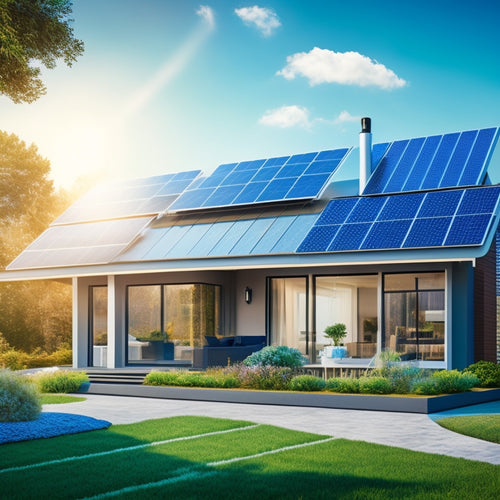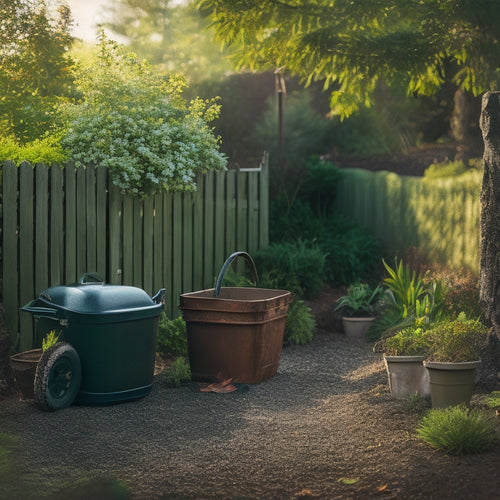
Balancing Home Energy: Efficient Techniques for Sustainability
Share
You can reduce your carbon footprint and save up to $2,000 annually by adopting efficient techniques that balance your home energy consumption. Start by optimizing your daily habits and routines, which account for 40% of your energy usage. Switch to energy-efficient LED bulbs and appliances, and consider solar-powered systems to reduce your reliance on the grid. By shifting non-essential appliances to off-peak hours and integrating smart home devices, you can further minimize your energy waste. As you investigate these techniques, you'll uncover even more opportunities to fine-tune your home's energy usage and create a more sustainable living space.
Key Takeaways
- Implement energy-efficient appliances and practices, such as LED bulbs and turning off unused electronics, to reduce daily energy consumption by up to 40%.
- Shift non-essential appliances to off-peak hours using load balancing strategies and smart plugs to minimize energy usage during peak hours.
- Integrate solar-powered systems and energy storage solutions to reduce reliance on the grid and stabilize peak demand, yielding annual savings of $500 to $2,000+.
- Utilize smart home systems and real-time energy monitoring to optimize energy distribution, identify inefficiencies, and make data-driven improvement decisions.
- Adopt sustainable practices, such as smart thermostats and energy audits, to minimize carbon footprint and enhance overall energy sustainability.
Optimizing Energy Consumption Patterns
Optimizing Energy Consumption Patterns
About 40% of your home's energy consumption is attributed to your daily habits and routines. By making a few simple changes, you can reduce your energy usage and contribute to a more sustainable future.
Start by replacing traditional incandescent bulbs with energy-efficient LED bulbs, which use considerably less power. Investing in solar-powered systems, like solar-powered charging stations, can also lead to potential annual savings of $500 to $2,000+.
Invest in energy-efficient appliances, such as LED TVs and power-saving refrigerators, to reduce your overall energy consumption.
Adopt sustainable living practices like turning off lights, electronics, and appliances when not in use. These small changes can add up to make a big impact on your energy consumption and contribute to a more environmentally friendly lifestyle.
Load Balancing for Peak Hours
Your home's energy usage spikes during peak hours, typically between 4 pm and 7 pm, when family members are getting ready for dinner or settling in for the evening.
To avoid overwhelming the grid and reduce your energy bills, it's important to implement load balancing strategies. This involves shifting non-essential appliances to off-peak hours or reducing their energy consumption during peak periods.
By optimizing your solar panel array design solar panel array optimization, you can maximize energy production and reduce your reliance on the grid during peak hours. Additionally, selecting energy-efficient charging equipment can also help minimize energy losses and reduce operating costs.
- Implement demand response programs that adjust your energy usage in response to peak hours, reducing strain on the grid.
- Practice peak shaving by reducing energy-intensive activities during peak hours, such as running multiple appliances simultaneously.
- Consider installing a smart plug to monitor and control energy usage of individual appliances, helping you make informed decisions about your energy consumption.
Smart Home Energy Distribution
A smart home energy distribution system is the backbone of an efficient and sustainable energy management strategy.
You'll be able to optimize your energy usage by integrating smart devices and appliances that work together seamlessly. For instance, a smart thermostat benefits include learning your schedule and preferences to adjust the temperature accordingly, reducing energy waste.
Conducting energy audits and load profiling can also help identify areas of energy inefficiency and optimize energy distribution.
Energy-efficient appliances, such as LED bulbs and Energy Star-rated devices, will also help minimize your carbon footprint.
By automating and controlling your energy distribution, you'll have real-time visibility into your energy consumption, making it easier to identify areas for improvement.
This system gives you the freedom to make informed decisions about your energy usage, reducing your reliance on the grid and your environmental impact.
Energy Storage System Integration
Integrating an energy storage system into your smart home energy distribution setup enables you to take your energy independence to the next level.
With a solar battery, you can store excess energy generated during the day for use during the night or on cloudy days. This setup allows you to optimize your energy management and reduce your reliance on the grid connection.
By minimizing grid reliance, you can also reduce your carbon footprint and stabilize the grid during peak demand periods. Additionally, on-site electricity generation provides backup power and lowers energy costs.
Some key benefits of energy storage system integration include:
- System scalability: easily add or remove storage capacity as needed
- Renewable integration: maximize your use of renewable energy sources
- Cost efficiency: reduce your energy bills and environmental impact
Real-Time Energy Monitoring Systems
With your energy storage system in place, you're now capable of optimizing your energy management.
Real-time energy monitoring systems take your energy efficiency to the next level by providing you with detailed energy usage analytics. These systems track your consumption behavior trends, helping you identify areas where you can cut back on energy waste.
By integrating smart charging technologies, you can further optimize your energy usage and reduce peak demand on the grid. You'll receive instant notifications when your energy usage spikes, allowing you to make adjustments on the fly.
By monitoring your energy usage in real-time, you'll gain a deeper comprehension of your energy needs and be able to make data-driven decisions to reduce your energy consumption.
This level of control and awareness gives you the freedom to optimize your energy usage and achieve true energy independence.
Frequently Asked Questions
Can I Still Use My Existing Appliances With a Smart Energy System?
You're not stuck in the dark ages with old appliances; most smart energy systems seamlessly integrate with your existing devices, offering a smooth shift to efficient energy management systems that free you from wasteful energy consumption.
How Do I Ensure My Energy-Efficient Upgrades Are Cost-Effective?
You'll want to weigh cost savings against upgrade options, considering factors like energy usage, maintenance costs, and potential rebates to guarantee your energy-efficient upgrades pay off in the long run.
Are Energy-Efficient Homes More Prone to Electrical Fires?
You're right to wonder if energy-efficient homes are more prone to electrical fires; however, with regular electrical inspections and adherence to fire safety protocols, you can minimize risks and enjoy the benefits of an eco-friendly living space.
Can I Integrate Renewable Energy Sources Into My Home's Energy System?
You can definitely integrate renewable energy sources into your home's energy system, exploring options like solar panel installation or wind turbine options, to reduce reliance on the grid and enhance your independence.
Do Energy-Efficient Homes Require More Maintenance Than Traditional Homes?
You'll find that energy-efficient homes don't necessarily require more maintenance; in fact, they're designed to reduce upkeep while maximizing energy savings. Follow simple maintenance tips, like regular filter changes and system checks, to guarantee your eco-friendly abode runs smoothly.
Related Posts
-

3 Ways Wind Power Boosts Home Value
Living near a wind farm can enhance your property's value in three significant ways. To begin with, proximity to wind...
-

7 Best Cool Roof Rebates for Energy-Savvy Homeowners
You're an energy-savvy homeowner looking to install a cool roof, and you're wondering which rebates can help you save...
-

10 Green Waste Solutions Every Homeowner Should Know
You can make a significant impact on the environment by implementing green waste solutions at home. Consider composti...


